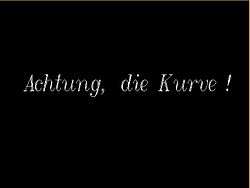Achtung, die Kurve!
| Achtung, die Kurve! | |
|---|---|
 | |
| Developer(s) | Filip Oscadal and Kamil Dolezal |
| Publisher(s) | Roy Heijmans |
| Platform(s) | DOS |
| Release date(s) | 1995 |
| Genre(s) | strategy |
| Mode(s) | Multiplayer |
Achtung, die Kurve!, also known as Zatacka or simply Achtung, is a freeware, multiplayer DOS computer game that supports from two-player up to eight-player gaming simultaneously. The game is a clone of the lesser known Cervi (Worms) from 1993, differing in that the lines now have holes. Author is Filip Oscadal, aka Fred Brooker, from the Czech Republic who made this game, together with Kamil Dolezal, for Amiga incl. music, sound effects and gfx background (worm speed depending on the picture). The game is supposedly from 1995 and written in Borland C++. The title is in German.
The game is similar to the game Tron, where players leave a trail and try to make the opponent hit a wall or a trail first. The game is controlled by only two buttons, to turn left or right. A key difference is that in Achtung, die Kurve!, players can turn and travel in any direction, not limited to the 4 cardinal directions.
Gameplay
Each player spawns as a dot at a random spot on the playing field, move at a constant speed. Each player has the ability to turn left or right, although the turning speed is limited such that sharp turns are not possible. As the dot travels across the playing field, it draws a permanent, solid line in its wake, in the color of that player. When the dot collides with any section of line or the boundary of the playing field, the player instantly loses, although the line remains in the playing field until the end of the game. The game becomes increasingly difficult as more of the playing field is blocked off by lines. Other players may try to draw barriers to block the path of other players, forcing them into a collision. However, as the lines are being drawn, gaps are occasionally being generated that can be used to escape a section of the map that has been blocked off. The game is won when all but one of the players has collided.
In its original version, there are a total of 6 different lines. Up to six people can play at the same time. All the lines are exactly the same, the color being the only thing setting the different lines apart. There are only two controls needed to control the lines.
Tournaments
Four major Achtung tournaments have been held over the years. The first one, held in the summer of 2004 in Utrecht, Netherlands, was won by the Turkish Nationals. This tournament became a major success and paved the way for an even bigger tournament 3 years later. In October 2007, a second tournament was held in Jakarta, Indonesia- in part of the nation's gaming tournaments. In front of a crowd of around 400, Indonesia's Mighty Badgers defeated Sam's Club from Singapore in the final. The majority of the contenders were part of IASAS schools. In December 2006, third tournament took place at Faculty of Electrical Engineering and Computing in Zagreb, Croatia. It was significant because professors also joined the tournament. In 2012 the first Worldwide Tournament for Achtung, die Kurve! has been held [1] where paying players of the game could attend in an online tournament. Maikkon won this first online tournament. In Sweden there have been Achtung Die Kurve tournaments for a couple of years at a LAN party called Birdie. There are around 1000 people at Birdie each year and 2012 the winner won a graphic card by AMD. In January 2012 there was an worldcup tournament in Denmark with players from 13 countries where 2 of the 98 players were girls. In the final there were 5 different countries playing for the WC win: Dennis Zorko (Slovakia), Robert Feltcak (Poland), Pontus Larsson (Denmark), Anton Westman (Norway), Hampus Karlsson (Sweden) and Jimmie Klum (Sweden). The final was played in 6 games. All the players did play with every control for a fair result. In the end Jimmie Klum was a clear winner, Anton took the second and Hampus the third place. The prize was 1000 Euro and was collected from the money you had to pay to be in the tournament.
References
- ↑ "Archived copy". Archived from the original on 2012-01-26. Retrieved 2012-01-17.